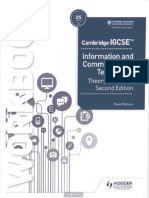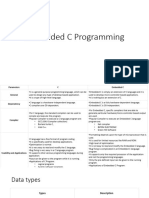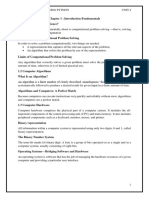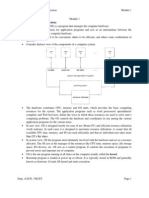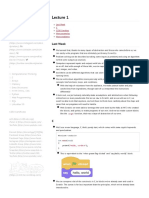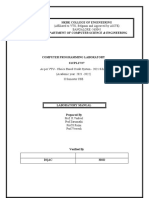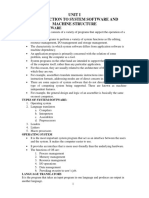0059 Primary Computing Assessment Guidance - tcm142-635628
Uploaded by
ritu bhatia0059 Primary Computing Assessment Guidance - tcm142-635628
Uploaded by
ritu bhatiaCambridge Primary
Assessment guidance for Cambridge Primary
Computing
Purposes for assessment
Whenever we decide to assess learners, we need to be clear about why we are doing so. Why we assess
learners (our selected purposes) will influence how and when we choose to do this. Here are two purposes for
assessing Primary learners.
1. Assessment to give information about current learning and to inform next steps
This type of assessment should happen every day during classroom activities. Whenever learners
demonstrate their current learning you can use this information to give them feedback and to inform your
next steps for them and the class.
The aim of this type of assessment is to uncover what a learner, or group of learners, currently knows,
understands, or can or cannot do. This allows you, as the teacher, to give timely and specific feedback to
help them improve. It will also inform next steps (for example, it will help you to decide whether to spend
more time on a learning objective, to go back to prior learning or to move on).
When this is the main purpose of an assessment, it is important to retain details rather than summarise
information as a single grade. For example, if a learner is to improve, it is much more useful to say
‘remember that most robots are not designed to look like a human’ than to say ‘all of the robots you have
drawn have heads, two arms and two legs’ or ‘you did that at a Grade C level’.
These informal, regular assessments are very important because you can make ongoing changes to
maximise progress during the learning process, rather than waiting until the end of a period of study.
Using assessments in this way can be called Assessment for Learning (AfL), formative assessment or
using assessment formatively. You can find information and advice on this process in Section 5 of the
Cambridge Primary Computing Teacher Guide.
2. Assessment to summarise achievement over a period of learning to give a grade
This type of assessment happens towards the end of a period of study (for example, a topic of study,
term, semester or stage). It aims to provide a summary that describes how well a learner has mastered
the knowledge, concepts and skills described in the learning objectives they have been learning over that
period.
The summary is often a grade which describes a level of performance. Common examples of grades
include bronze / silver / gold; working towards expected standard / at expected standard / above expected
standard; and letters or numbers.
The grade given can be used to compare a learner’s overall performance in different subjects or to
compare the performance of learners in different classes, stages or schools. For example, Cambridge
Primary Checkpoint for English, English as a Second Language, Mathematics, Science and Global
Perspectives all provide a grade or standardised score. Assessments used in this way can be called
summative assessments.
Although many Cambridge Primary subjects have a Cambridge Primary Checkpoint, there is currently no
Cambridge Primary Checkpoint for Computing. This document provides guidance on other ways to assess
Cambridge Primary Digital Literacy.
Assessment guidance for Cambridge Primary Computing 1
Activities that can be used for assessing Computing
It is a common misconception that different activities are used for different types of assessment. Often the
same activities can provide information which you can use for your intended assessment purpose (i.e. to give
information on current learning and to inform next steps, or to summarise achievement over a period of
learning).
When deciding what activities and tasks to use to assess your learners in Cambridge Primary Computing, you
may wish to note the following points:
Your learners will show what they know, understand and can do in different ways. Some assessments
can be based on what learners write or say in response to questions (for example, in group discussions).
But in Primary Computing some of the most relevant evidence will be what learners demonstrate through
the production of algorithms, programs, representations of data and/or through your observations of them
discussing computer software or hardware.
Give your learners the opportunity to perform tasks that reflect their age and attainment. The suggested
activities in the schemes of work give suggestions of age-appropriate activities, although you can
substitute these for other activities. Opportunities for assessing Primary Computing include when
learners:
o create algorithms for sets of specific instructions
o create programmes that combine programming constructs
o correct or change algorithms and programs
o explain the differences between input and output, software and hardware
o interact with different datasets to show how they are collected, stored and analysed
Learners should have experience of creating algorithms and programs for different contexts. They should
also be able to demonstrate the use of different programming constructs and be able to combine these in
their programmed solutions. You can choose how many of these you wish to assess.
A single piece of work or activity is unlikely to cover all of the learning objectives although it may cover
learning from more than one. Aim to build a more comprehensive representation of learners’ knowledge
by looking at learners’ work and interactions in a range of contexts and through a range of activities.
Seek to identify whether a learner can consistently achieve a learning objective over a period of time
rather than focusing on a single piece of work.
It can be very powerful to involve learners in identifying their progress and next steps. In Primary
Computing you can use digital tools, across a range of contexts and media, to record the process a
learner used to improve their knowledge or skills as well as to identify how their knowledge and skills
came together in their final project or other output. As an example, learners can create a portfolio of their
algorithms and programming projects. They can also add comments to their program code to explain their
intentions, achievements, and future goals.
Assessment guidance for Cambridge Primary Computing 2
Recording achievement
We strongly recommend that you agree an approach within your school which means that records are simple,
quick and easy to keep and maintain. Extensive, frequent record keeping can easily distract you from more
important classroom activities.
The learning objectives in the curriculum framework provide a structure against which learners’ knowledge,
understanding and skills development can be checked. One possible approach for checking progress against
the learning objectives is:
Working towards the learning At standard of learning Above standard of learning
objective objective objective
Learners can apply some, but Learners can apply the Learners can apply the
not all, of the knowledge, knowledge, understanding knowledge, understanding and
understanding and/or skills and/or skills described in the skills described in the learning
described in the learning learning objective in some objective in a wide range of
objective in limited contexts contexts, especially familiar contexts, including unfamiliar
only. and simple contexts. and complex contexts.
Learners may demonstrate Learners may start to
some of the knowledge, demonstrate some of the
understanding and/or skills knowledge, understanding
described in the learning and/or skills described in the
objectives for a lower stage. learning objectives for a higher
stage.
A possible method for recording progress based on this approach is described below.
Have a look at this description of a Stage 6 learner:
Safiya wants to demonstrate that she knows the similarities and differences between two robotic
vehicles: a public service taxi and a warehouse floor robot in a distribution company.
She wrote a clear design brief for both vehicles demonstrating her understanding of inputs, wireless
technology, and aesthetic requirements of the vehicle design.
However, she was unable to specify the benefits of the two vehicles compared to machines
controlled by a human operator.
Here is an example with learning objectives from the Managing Data, Networks and Digital
Communication and Computer Systems strands. It records whether this learner is working towards, at, or
above the standard of each learning objective.
Assessment guidance for Cambridge Primary Computing 3
Managing Data Working towards / At /
Above
6MD.07 Know that data is used to solve problems within a range of industries, Above expected standard
including health, manufacture and retail.
Networks and Digital Communication Working towards / At /
Above
6DC.02 Explain that devices can transfer data wirelessly using radio waves, At expected standard
including wi-fi and cellular networks.
Computer Systems Working towards / At /
Above
6CS.01 Know how to select hardware and software components, while Above expected standard
considering a range of factors such as functionality, cost, speed and aesthetics.
6CS.07 Know that robots can work autonomously. At expected standard
6CS.08 Identify benefits of using robotics in industry, such as car manufacturing Below expected standard
or food production.
Giving feedback to learners
Your records can be used to give feedback to learners. For example, you can discuss with a learner their
progress towards particular learning objectives and what they need to do to improve further. This is particularly
important if your purpose for assessment is to give information about current learning and next steps.
You can find more information on giving feedback in Section 5.5 of the Cambridge Primary Computing
Teacher Guide.
Assessment guidance for Cambridge Primary Computing 4
Reporting results
This section applies to anyone who is responsible for deciding the reporting strategy for their school or subject.
Consider these different styles of reports and their accompanying strengths and weaknesses.
Report 1: a summary statement for the subject
Computing At expected standard.
Report 1 is simple to understand and makes it easy to compare a learner’s attainment between subjects. It is
likely that this style of report will require limited record keeping by teachers. However, there is not enough
information to indicate how an individual learner might make progress.
Report 2: a summary statement for the subject and a comment
Computing At expected standard. Demonstrates good awareness that
computers function using a
combination of hardware and
software, inputs and outputs.
Report 2 is similar to Report 1 but the additional comment lets teachers give some feedback on how to
progress further.
Report 3: a summary statement for each curriculum strand
Computing At expected standard.
Computational Thinking Working towards expected standard.
Programming At expected standard.
Managing Data At expected standard.
Networks and Digital Communication At expected standard.
Computer Systems Above expected standard.
Report 3 is still simple to understand but might require more time for teachers to complete than Reports 1 or 2.
It allows learners, and their parents, to identify strengths and areas for improvement within a subject as well as
compare between subjects.
Report 4: a summary statement for every learning objective (excerpt)
Managing Data
6MD.01 Identify the role of different computing tools At expected standard.
when planning a statistical investigation.
6MD.02 Design an appropriate form to capture Working towards expected
continuous data for a given purpose. standard.
6MD.03 Design a spreadsheet that includes a At expected standard.
combination of features, including cell referencing,
arithmetic operators and functions (SUM, AVERAGE).
6MD.04 Select data that is relevant for a particular Above expected standard.
purpose.
6MD.05 Design and create a single table database, Working towards expected
including data attributes and data types, for a given standard.
Assessment guidance for Cambridge Primary Computing 5
purpose.
6MD.06 Know how to use phrase searching to find Working towards expected
information in a database. standard.
6MD.07 Know that data is used to solve problems within At expected standard.
a range of industries, including health, manufacture and
retail.
Report 4 is a much more detailed and extensive document as it lists every learning objective. This level of
detail can be confusing for non-specialists to understand (i.e. parents) but can help identify particular areas of
strength and areas for improvement.
You can choose to use different styles of reports at different times of the year. For example, you could use
Report 2 at the end of Terms 1 and 2. Then you could have a fuller report in the style of Report 3 at the end of
the school year.
Whichever type of report you choose to use, it is important that it provides value to learners and parents. It is
also important that it does not take too much time for teachers to produce. Teachers can also get value from
monitoring the progress of a class by identifying areas that their current class needs more time on, and ways
to improve their teaching for future classes.
Copyright © UCLES September 2021 v1
Assessment guidance for Cambridge Primary Computing 6
You might also like
- Cambridge Primary Learner's Computing Book 486% (7)Cambridge Primary Learner's Computing Book 493 pages
- 0059 Primary Computing Curriculum Framework 2021 - tcm142-635600100% (3)0059 Primary Computing Curriculum Framework 2021 - tcm142-63560037 pages
- International Computing For Lower Secondary Students Book Stage - 8No ratings yetInternational Computing For Lower Secondary Students Book Stage - 8201 pages
- 0059 Computing Scheme of Work Stage 6 v1.0 - tcm142-635622No ratings yet0059 Computing Scheme of Work Stage 6 v1.0 - tcm142-635622121 pages
- Cambridge Primary Computing: Mulit-Component Sample50% (2)Cambridge Primary Computing: Mulit-Component Sample28 pages
- Hodder Education Cambridge Primary Computing67% (3)Hodder Education Cambridge Primary Computing1 page
- 0860 Computing Scheme of Work - Stage 8 - v1 - tcm143-635635No ratings yet0860 Computing Scheme of Work - Stage 8 - v1 - tcm143-635635107 pages
- Primary Digital Literacy Stage 5 Scheme of WorkNo ratings yetPrimary Digital Literacy Stage 5 Scheme of Work33 pages
- 0059 Computing Learning Objectives Only - tcm142-635602No ratings yet0059 Computing Learning Objectives Only - tcm142-63560213 pages
- Primary Digital Literacy Stage 3 Scheme of Work100% (1)Primary Digital Literacy Stage 3 Scheme of Work36 pages
- Computing Year 7 Flowcharts and Problem Solving Study Booklet - 1No ratings yetComputing Year 7 Flowcharts and Problem Solving Study Booklet - 152 pages
- 0417 - Scheme - of - Work - Information and Communication TechnologyNo ratings yet0417 - Scheme - of - Work - Information and Communication Technology64 pages
- Digital Literacy Stage 9 Scheme of Work - tcm143-552768No ratings yetDigital Literacy Stage 9 Scheme of Work - tcm143-55276841 pages
- CambridgePrimary - Scheme of Work All Subjects100% (7)CambridgePrimary - Scheme of Work All Subjects4 pages
- Cambridge Primary Resource List, Mathematics Stages 1,2,3100% (1)Cambridge Primary Resource List, Mathematics Stages 1,2,38 pages
- Scheme of Work: Cambridge IGCSE Information and Communication Technology 0417No ratings yetScheme of Work: Cambridge IGCSE Information and Communication Technology 041762 pages
- Digital Literacy: For Lower Secondary School100% (1)Digital Literacy: For Lower Secondary School18 pages
- Essential Computing Primary 5 Teachers Guide 9789988896515ARNo ratings yetEssential Computing Primary 5 Teachers Guide 9789988896515AR120 pages
- 0860 Lower Secondary Computing Assessment Guidance - tcm143-635637No ratings yet0860 Lower Secondary Computing Assessment Guidance - tcm143-6356376 pages
- Primary Digital Literacy Stage 1 Scheme of WorkNo ratings yetPrimary Digital Literacy Stage 1 Scheme of Work42 pages
- GRD 7 - 0860 Computing Scheme of Work - Stage 8 - v1 - tcm143-635635No ratings yetGRD 7 - 0860 Computing Scheme of Work - Stage 8 - v1 - tcm143-635635107 pages
- Primary Digital Literacy Stage 4 Scheme of WorkNo ratings yetPrimary Digital Literacy Stage 4 Scheme of Work43 pages
- GRD 6 - 0860 Computing Scheme of Work Stage 7 v2 - tcm143-635634No ratings yetGRD 6 - 0860 Computing Scheme of Work Stage 7 v2 - tcm143-635634119 pages
- Download full Cambridge Primary Computing Learner s Book Stage 5 Birbal ebook all chapters100% (3)Download full Cambridge Primary Computing Learner s Book Stage 5 Birbal ebook all chapters50 pages
- Ict Syllabus For Primary School StudentsNo ratings yetIct Syllabus For Primary School Students12 pages
- 0838 Primary Global Perspectives Checkpoint Instructions - tcm142-652604No ratings yet0838 Primary Global Perspectives Checkpoint Instructions - tcm142-65260420 pages
- Scheme of Work - Mathematics Stage 2: Cambridge Primary50% (2)Scheme of Work - Mathematics Stage 2: Cambridge Primary42 pages
- 0096 Primary Maths Stage 1 Scheme of Work_tcm142-594955No ratings yet0096 Primary Maths Stage 1 Scheme of Work_tcm142-59495579 pages
- 0417 Scheme of Work (For Examination From 2023)100% (1)0417 Scheme of Work (For Examination From 2023)41 pages
- Hodder Education Computing Catalogue 2022 23No ratings yetHodder Education Computing Catalogue 2022 2340 pages
- dokumen.pub_cambridge-primary-computing-learners-book-stage-3-9781398368583-139836858x_compressedNo ratings yetdokumen.pub_cambridge-primary-computing-learners-book-stage-3-9781398368583-139836858x_compressed202 pages
- 0072 Primary Digital Literacy Curriculum Framework 2019 - tcm142-552561 PDFNo ratings yet0072 Primary Digital Literacy Curriculum Framework 2019 - tcm142-552561 PDF17 pages
- 0860 Computing Scheme of Work - Stage 9 - v1 - tcm143-635636No ratings yet0860 Computing Scheme of Work - Stage 9 - v1 - tcm143-635636128 pages
- 0065 Primary Humanities Curriculum Framework 2024 - tcm142-71856167% (3)0065 Primary Humanities Curriculum Framework 2024 - tcm142-71856134 pages
- Inspire International Computing - Year 7No ratings yetInspire International Computing - Year 713 pages
- Cambridge Ict Starters Administrative Guide 2018 PDFNo ratings yetCambridge Ict Starters Administrative Guide 2018 PDF29 pages
- Primary - AsstGuidance - Digital Literacy - v1 - tcm142-554710No ratings yetPrimary - AsstGuidance - Digital Literacy - v1 - tcm142-5547106 pages
- LowerSec_AsstGuidance_Digital Literacy_v1_tcm143-554725No ratings yetLowerSec_AsstGuidance_Digital Literacy_v1_tcm143-5547256 pages
- CLASS 12 Computer Science Practical - Report Files 2022 2023No ratings yetCLASS 12 Computer Science Practical - Report Files 2022 202339 pages
- Sat - 15.Pdf - Online Subjective Answer CheckerNo ratings yetSat - 15.Pdf - Online Subjective Answer Checker11 pages
- Executive Secretary Training Needs Assessment Evaluation FormNo ratings yetExecutive Secretary Training Needs Assessment Evaluation Form8 pages
- Logix5000 Controllers Add-On InstructionsNo ratings yetLogix5000 Controllers Add-On Instructions82 pages
- First Program in JAVA 2. Data Types in JAVA 3. Operators in JAVA 4. Input/output in JAVANo ratings yetFirst Program in JAVA 2. Data Types in JAVA 3. Operators in JAVA 4. Input/output in JAVA15 pages
- Intermediate Python Nanodegree Program SyllabusNo ratings yetIntermediate Python Nanodegree Program Syllabus10 pages
- A History of Computer Programming LanguagesNo ratings yetA History of Computer Programming Languages5 pages
- Module1: Question Bank: Syllabus: Why Should You Learn To Write Programs, Variables, Expressions and StatementsNo ratings yetModule1: Question Bank: Syllabus: Why Should You Learn To Write Programs, Variables, Expressions and Statements10 pages
- Unit I Introduction To System Software and Machine StructureNo ratings yetUnit I Introduction To System Software and Machine Structure9 pages



















































